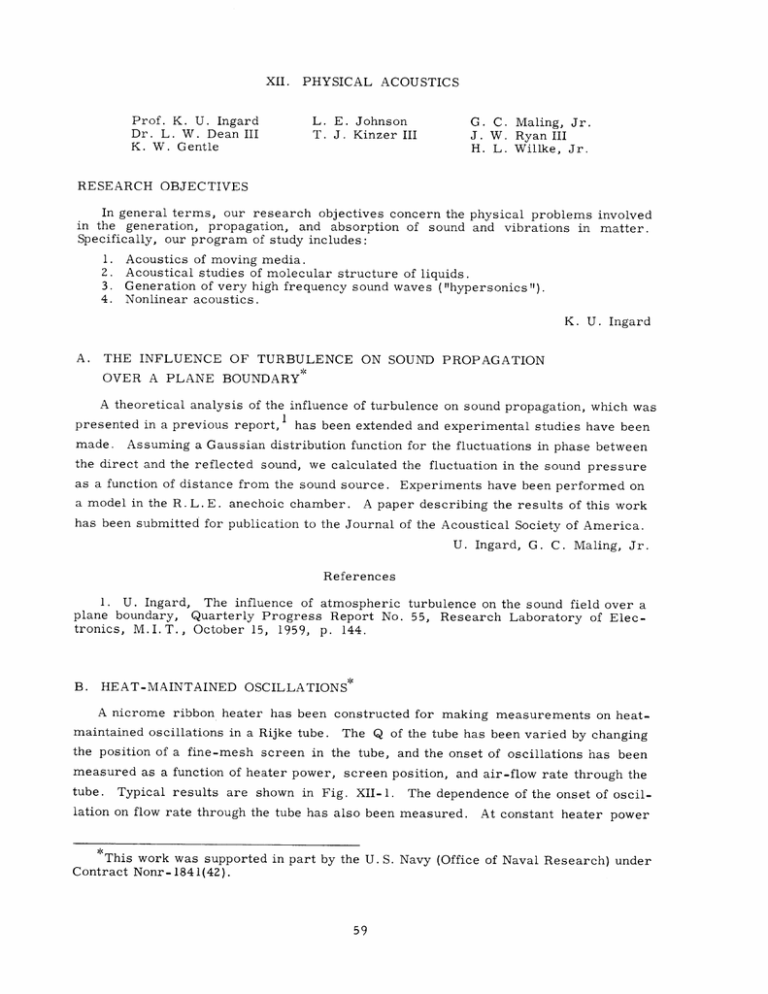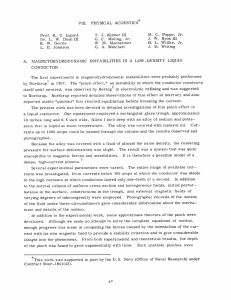XII. PHYSICAL ACOUSTICS Prof. K. U. Ingard
advertisement

XII. PHYSICAL ACOUSTICS Prof. K. U. Ingard Dr. L. W. Dean III K. W. Gentle L. E. Johnson T. J. Kinzer III G. C. Maling, Jr. J. W. Ryan III H. L. Willke, Jr. RESEARCH OBJECTIVES In general terms, our research objectives concern the physical problems involved in the generation, propagation, and absorption of sound and vibrations in matter. Specifically, our program of study includes: 1. 2. 3. 4. Acoustics of moving media. Acoustical studies of molecular structure of liquids. Generation of very high frequency sound waves ("hypersonics"). Nonlinear acoustics. K. U. A. Ingard THE INFLUENCE OF TURBULENCE ON SOUND PROPAGATION OVER A PLANE BOUNDARY* A theoretical analysis of the influence of turbulence on sound propagation, which was presented in a previous report, l has been extended and experimental studies have been made. Assuming a Gaussian distribution function for the fluctuations in phase between the direct and the reflected sound, we calculated the fluctuation in the sound pressure as a function of distance from the sound source. a model in the R. L. E. anechoic chamber. Experiments have been performed on A paper describing the results of this work has been submitted for publication to the Journal of the Acoustical Society of America. U. Ingard, G. C. Maling, Jr. References 1. U. Ingard, The influence of atmospheric turbulence on the sound field over a plane boundary, Quarterly Progress Report No. 55, Research Laboratory of Electronics, M.I.T., October 15, 1959, p. 144. B. HEAT-MAINTAINED OSCILLATIONS* A nicrome ribbon heater has been constructed for making measurements on heatmaintained oscillations in a Rijke tube. The Q of the tube has been varied by changing the position of a fine-mesh screen in the tube, and the onset of oscillations has been measured as a function of heater power, screen position, and air-flow rate through the tube. Typical results are shown in Fig. XII-1. The dependence of the onset of oscil- lation on flow rate through the tube has also been measured. At constant heater power *This work was supported in part by the U. S. Navy (Office of Naval Research) under Contract Nonr- 1841(42). (XII. PHYSICAL ACOUSTICS) -5 1290 -10 o IIOC x 930 AIR VEL -15 50 w z -20 0 45 Q UJ -25 = E 40 5 10 DISTANCE FROM OPEN END Fig. XII-1. 15 OF TUBE (INCHES) NO SCREEN Relative sound-pressure level and Q as a function of the position of a screen in the Rijke tube. (1290 watts) the tube will oscillate when the air-flow rate is between approximately 100-250 ft per min. These experimental results can be compared with the analysis performed by Merk 1 When the approwho used a heat-transfer function for ribbons obtained by Carrier. priate constants are used, it is found that the analysis predicts that the oscillations should occur over a much greater range of air-flow rate than is observed experimentally. The analysis is also not sensitive enough to the Q of the tube to be able to predict the dependence of the onset of oscillations on the screen position. This work is being continued, with emphasis on gaining a better understanding of the scattering of sound by a heat source. G. C. Maling, Jr. References C. Appl. Sci. Research A6, I. H. J. Merk, 2. G. F. Carrier, Quart. Appl. Math. 402 (1957). 12, 383 (1955). INSTABILITY OF LIQUID CONDUCTORS* Investigations on the stability of liquid conductors, which were presented in a pre- vious report, are being conducted. The program involves subjecting a homogeneous *This work was supported in part by the National Science Foundation (Grant G-9330). (XII. PHYSICAL ACOUSTICS) trough of conductor to high current densities and observing the conditions under which pinch instability develops. The liquid conductor used is an alloy of sodium and potassium which becomes liquid at room temperature. This material was chosen for its high electric conductivity, which permits high current densities without overheating, and low density. The low density is a singular advantage, for it permits the covering of the alloy with a hydrocarbon liquid of almost the same density, thereby almost cancelling hydrostatic pressure as a restoring force to surface deformations. The result is that static instabilities in a low-density, high-current medium can be readily stimulated. In the experimental array, care is being taken to maintain symmetry and keep the conductor in a homogeneous magnetic field. The techniques of preparing and handling the alloy have been developed. It is stored best under dried, outgassed kerosene and transferred with a syringe. Other techniques either expose it to air, which corrodes it rapidly, or disperse it into droplets that fail to coalesce readily. A chamber has been built to keep the material under test in an inert N2 atmosphere. If the alloy should pinch and vaporize, it will not ignite the metal and hydrocarbons. Preliminary trials revealed slight pinches at a current of 300 amps into a cross 2 section of approximately 3 cm , but these were at the ends where the cross section was reduced because the alloy did not wet copper electrodes. A pilot test revealed that sodium metal electrodes gave improved results, since the alloy readily wets sodium, and experiments are continuing with this configuration. A bank of six storage batteries supplies up to 1000 amps through a stainless-steel rod current-limiting resistor immersed in water. K. W. Gentle, U. Ingard References 1. D. S. Wiley and U. Ingard, Bifurcation instability of a liquid conductor in an axial magnetic field, Quarterly Progress Report No. 63, Research Laboratory of Electronics, M.I.T., October 15, 1961, p. 133; U. Ingard and D. S. Wiley, Search for a stable pinch in a horizontal mercury column, Quarterly Progress Report No. 63, p. 135.





